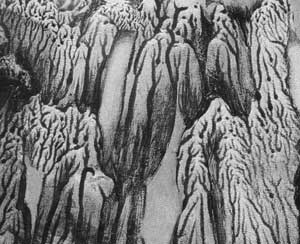Seeing Things in Things
I cannot forbear to mention among these precepts a new device for study which, although it may seem but trivial and almost ludicrous, is nevertheless extremely useful in arousing the mind to various inventions. And this is, when you look at a wall spotted with stains, or with a mixture of stones, if you have to devise some scene, you may discover a resemblance to various landscapes, beautified with mountains, rivers, rocks, trees, plains, wide valleys and hills in varied arrangement; or again you may see battles and figures in action; or strange faces and costumes, and an endless variety of objects, which you could reduce to complete and well drawn forms. And these appear on such walls confusedly, like the sound of bells in whose jangle you may find any name or word you choose to imagine.
-Leonardo Da Vinci
This facility to see things in other things is perhaps most potent in childhood, when the open door of a closet at night really does reveal a monster. As we grow older we realize that the monsters don't actually exist (although Ripley would have us believe otherwise), but the facility remains.
It's possible that the facility isn't limited to humans. This is supposedly an example of Neanderthal art. Personally I'm not convinced: not because I have a low estimation of Neanderthals (I don't know any), but in this case I'd ask the question: who is it that is seeing the face?
Neanderthal #1: This rock looks like a face!
Neanderthal #2: I don't see it.
Neanderthal #1: Wait, what if I shove a bone in here...and here.
Neanderthal #2: It still looks like a rock to me.
Maybe it isn't even limited to primates: the ability to resolve a lion in the shadows would certainly be a survival trait, even if the lion isn't always there. Anyone who owns a cat or a dog knows that they dream, and if they can construct a whole world to react to in their sleep, who's to say that they don't see things in other things (Turing's test might apply here: if they behave like us you have to give them the benefit of the doubt).
What perhaps is limited to humans (and their close cousins) is the ability (desire, need?) to alter their environment to resemble the things that they see in it. At some point we stopped simply seeing animals in the stains on walls and started tracing their lines.
If you start with a white thing, you are going to project things you already know. Make it dirty somehow and then you will start using hallucinations.
-Roberto Matta
I've said elsewhere that fractal art is what artists do with fractals. If you accept that (and I'm sure not everyone will) then we can claim some of the greatest artists of the 20th century into the ranks of fractal artists. The one who has had the most influence on me is Max Ernst. From the 1940s he used a process called decalcomania in many of his paintings, which entails pressing paint between two surfaces and pulling them apart. The result is what we would now call a fractal pattern.

Ernst used decalcomania to make his canvas "dirty" and, in Matta's words, started "using hallucinations", devising scenes stranger than Da Vinci's landscapes and battles.
Computer generated fractals can be viewed as just another way of making a dirty canvas. I believe that fractals have no value in themselves, no inherent beauty. They are simply a starting point for our "hallucinations".





3 Comments:
Very interesting stuff. I would consider decalcomania (sounds like a sticker convention) to be algorithmic. I don't know enough about fractal theory to say it's fractal or not, but it certainly has a fractal look. So Max Ernst pushes out Jackson Pollock as the first fractal artist (post-processor too).
What I find most interesting about your post is the inspirational quality of fractals and algorithmic imagery (and dirt) that you've pointed out. I like to browse through images on my computer until I see one that suggests a short anectdote I could write. I've tried doing it the other way; writing a short anectdote and looking for an image to illustrate it, but it doesn't seem to work as well.
Inuit (eskimo) carvers often take a piece of soapstone and turn it over and over in their hands before "discovering" the animal that's inside and then "revealing" it by their carving.
I like your definition of fractal art too. The artist is part of the process, even if it's just a matter of choosing what to zoom into or what to save. Computers and programming will never be more than mere tools, although possibly very powerful ones.
9/12/2006 1:47 PM
Mark,
I agree with your take on Ernst and fractal forms, and it's strange you should mention him. I was struck by the eerie similarities between this collage still of his (from the short film Kindness Week) and your recent image Proof.
9/12/2006 7:47 PM
Oh, I hadn't seen that one. It's perhaps not so strange, since Ernst has influenced my recent fractal collages as well.
9/12/2006 8:18 PM
Post a Comment
<< Home